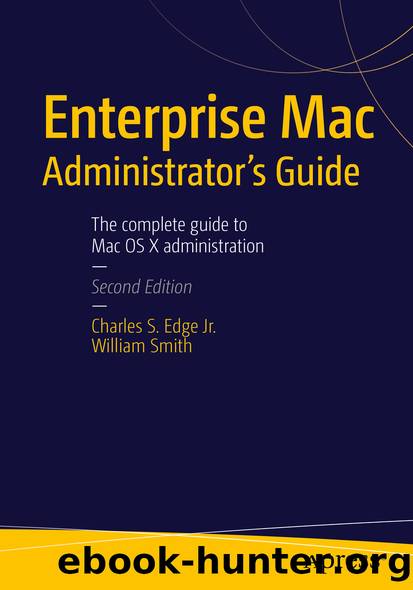Enterprise Mac Administrator’s Guide by Charles S. Edge & William Smith

Author:Charles S. Edge & William Smith
Language: eng
Format: epub
Publisher: Apress, Berkeley, CA
User Templates
New users on Mac computers have a certain set of default settings that are copied into their user profiles the first time they log in. If a home directory for a user doesn’t exist when that person first logs in, the system will create a new one using the contents of the directory /System/Library/User Template/English.lproj as a template (for English users). You can modify the contents of this directory, copying new files or editing existing ones. When someone creates a new account, the system will copy these files into it. This customizes the look and feel, default documents, fonts, and other aspects of user accounts without you having to do so each time you create a new user or whenever someone logs in for the first time. (In OS X 10.11 El Capitan, the User Template folder is exempt from Apple’s new System Integrity Protection feature, which disallows modifying certain system folders such as System.)
This can be incredibly useful when you’re not using network or mobile accounts, when you have a number of different people logging into computers, or when you want to provide specific settings or files. It goes without saying that you could set many policies more easily using configuration profiles, but this won’t always cover the settings you want, and modifying the User Template folder can be easier in many circumstances.
For example, let’s say you want to provide all users with a default set of stock fonts. By simply copying fonts into the /System/Library/User Template/English.lproj/Library/Fonts directory, you’ll provide the fonts to users when they log in. You could just install the fonts in /Library/Fonts and be done with it, but a user who has the fonts in the home directory can remove them, if needed, rather than being stuck with them. The same would be true for any items stored in the home directory, including Microsoft Office preferences, many of which you can’t manage via profiles.
You can also employ the User Template folder to perform scripts the first time a new employee logs in. For example, if you have a Microsoft Exchange environment, you can have Outlook automatically set up a user account on the person’s initial login by having a self-destructing launch agent in the user’s home folder (∼/Library/LaunchAgents). This would put the LaunchAgents folder, a script, and the agent itself in the User Template folder, but if you have a large number of users, it would save a lot of time in setup.
Of course, if you’re using Open Directory, Active Directory, or some other directory service, there are better ways to accomplish much of what you can do with the User Template folder. Still, templates are great tools to keep in your tool belt.
Download
This site does not store any files on its server. We only index and link to content provided by other sites. Please contact the content providers to delete copyright contents if any and email us, we'll remove relevant links or contents immediately.
Grails in Action by Glen Smith Peter Ledbrook(9163)
Sass and Compass in Action by Wynn Netherland Nathan Weizenbaum Chris Eppstein Brandon Mathis(8808)
Azure Containers Explained by Wesley Haakman & Richard Hooper(7440)
Configuring Windows Server Hybrid Advanced Services Exam Ref AZ-801 by Chris Gill(7432)
Kotlin in Action by Dmitry Jemerov(7263)
Running Windows Containers on AWS by Marcio Morales(6981)
Microsoft 365 Identity and Services Exam Guide MS-100 by Aaron Guilmette(5399)
Microsoft Cybersecurity Architect Exam Ref SC-100 by Dwayne Natwick(5208)
Combating Crime on the Dark Web by Nearchos Nearchou(4978)
The Ruby Workshop by Akshat Paul Peter Philips Dániel Szabó and Cheyne Wallace(4667)
Management Strategies for the Cloud Revolution: How Cloud Computing Is Transforming Business and Why You Can't Afford to Be Left Behind by Charles Babcock(4527)
Python for Security and Networking - Third Edition by José Manuel Ortega(4233)
The Age of Surveillance Capitalism by Shoshana Zuboff(4209)
Learn Wireshark by Lisa Bock(4115)
The Ultimate Docker Container Book by Schenker Gabriel N.;(3886)
Learn Windows PowerShell in a Month of Lunches by Don Jones(3681)
DevSecOps in Practice with VMware Tanzu by Parth Pandit & Robert Hardt(3566)
Windows Ransomware Detection and Protection by Marius Sandbu(3540)
Blockchain Basics by Daniel Drescher(3507)
